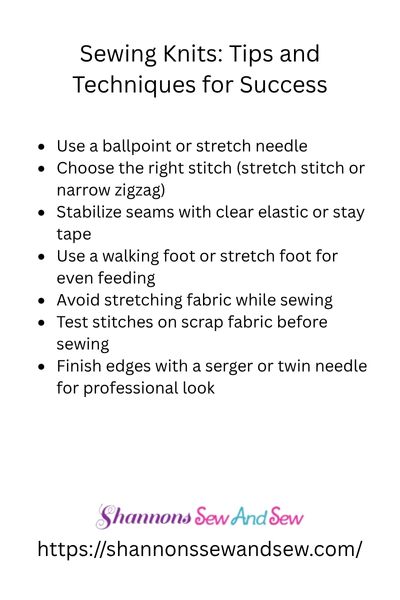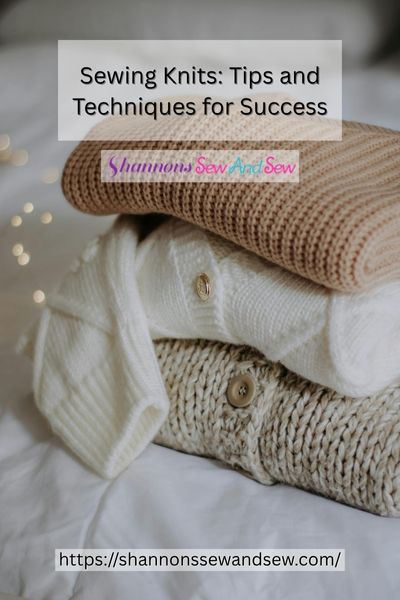Sewing Tips
Sewing Knits: Tips and Techniques for Success
Ever sat down to your sewing machine, excited to start a new project, only to realize—oh no—you’re working with knits? Yep, Sewing knits tips and techniques is something every sewist eventually goes searching for. Trust me, I’ve been there too, and let me tell you, it doesn’t have to be scary.
Read More About Sewing Knits: Tips and Techniques for Success

My First Time Sewing Knits (Spoiler: I Almost Cried)
Let me set the scene: I’d found this awesome, soft-as-a-cloud jersey fabric at a local shop. My brain was screaming, This is perfect for a casual tee! I ran home, prepped my pattern, and confidently threaded my machine. Ten minutes in—disaster. The fabric stretched, wiggled, and bunched in ways that made me question my life choices.
I eventually figured it out (after a few snacks and deep breaths), and now I actually prefer sewing knits over woven fabric for a lot of things. It just takes the right know-how and a few insider tricks. So let’s dive into sewing knits tips and techniques —minus the tears.
More Things to Know About Sewing Knits: Tips and Techniques for Success

Know Your Knit Types (And Why It Matters)
There’s a massive difference between a stable interlock knit and a slinky rayon-spandex blend. If you’re sewing a hoodie, you’ll want something like French terry or sweatshirt fleece—something beefy. For a tank top? Go for a lightweight jersey. Stretch percentage and recovery are also big deals. You don’t want your neckline sagging like an old gym sock after one wear, right?
Here’s what I learned: always give your fabric a little tug in both directions before cutting. If it stretches a lot, your seams need to accommodate that. If it barely moves, you might get away with treating it more like a woven.
The Right Tools Make a Huge Difference
You don’t need a fancy serger to master sewing knits tips and techniques—though if you’ve got one, high five! But even with a regular ol’ sewing machine, you can do a lot. Just switch to a ballpoint needle. Seriously. I once forgot and ended up punching tiny holes all down my sleeve seams. Not a good look.
Also, stretch thread like Woolly Nylon can be a game-changer for hems, and using a walking foot? Oh man, it’s like giving your machine power steering. It helps feed the fabric evenly so nothing gets stretched out of shape.
Stitch Settings You’ll Actually Use
Let’s keep this real. You don’t need to overthink your stitches. For basic seams, I love a narrow zigzag or the lightning bolt stitch (if your machine has it). Straight stitches? Nah. Unless you want popped seams.
When hemming, I go for a double needle. It looks professional and stretches with the fabric. Sure, threading two spools can feel like a magic trick at first, but it gets easier. And the results are worth it. You’ll feel like a sewing superhero, promise.
Cut with Confidence (Not Panic)
One of the most frustrating parts about sewing knits is that they love to curl up like they’re trying to avoid being cut. The trick? Spray starch. Yep, I spray a light mist and press the edges. Makes a world of difference. Also, cutting with a rotary cutter instead of scissors helps keep everything flat and precise.
Let’s be honest—half the battle with sewing knits tips and techniques is just keeping the fabric from misbehaving before you even sew a single stitch.
Fit Is Friend, Not Foe
Here’s a surprise I learned the hard way: knits are forgiving—but they also hide mistakes and exaggerate them. Weird, right? Because they stretch, a slightly off measurement might not be a big deal… or it might pull in all the wrong places.
That’s why I always baste seams first when trying a new pattern. It’s a simple step that saves so much frustration. If you try it on and something feels weird, just unpick and adjust. No harm done.
Mistakes? Been There, Sewn That
Don’t let a wonky hem or stretched-out neckline get you down. You’re not failing, you’re learning. I once accidentally sewed the sleeve opening shut on a knit top—didn’t even notice until I tried it on. Classic.
The good thing is, most knit fabrics are forgiving. You can often snip, resew, or just live with a little quirk. Handmade doesn’t have to mean perfect. It should mean yours.
Wrapping Up: Sewing Knits Tips and Techniques for Success
So, if you’ve been avoiding knits, I get it. They can be a little intimidating at first. But once you figure out how to handle them, they open up a whole new world of comfy clothes, cool textures, and creative freedom.
My advice? Grab that stretch fabric you’ve been side-eyeing and give it a go. Use the tips we talked about—get your gear right, play with stitches, and don’t beat yourself up if things get weird. Because honestly, sewing knits tips and techniques is really just about getting comfortable with being a little uncomfortable at first.
And hey, if your first shirt turns out more “abstract art” than “wardrobe staple,” just wear it proudly while sewing the next one.
You’ve got this.






















